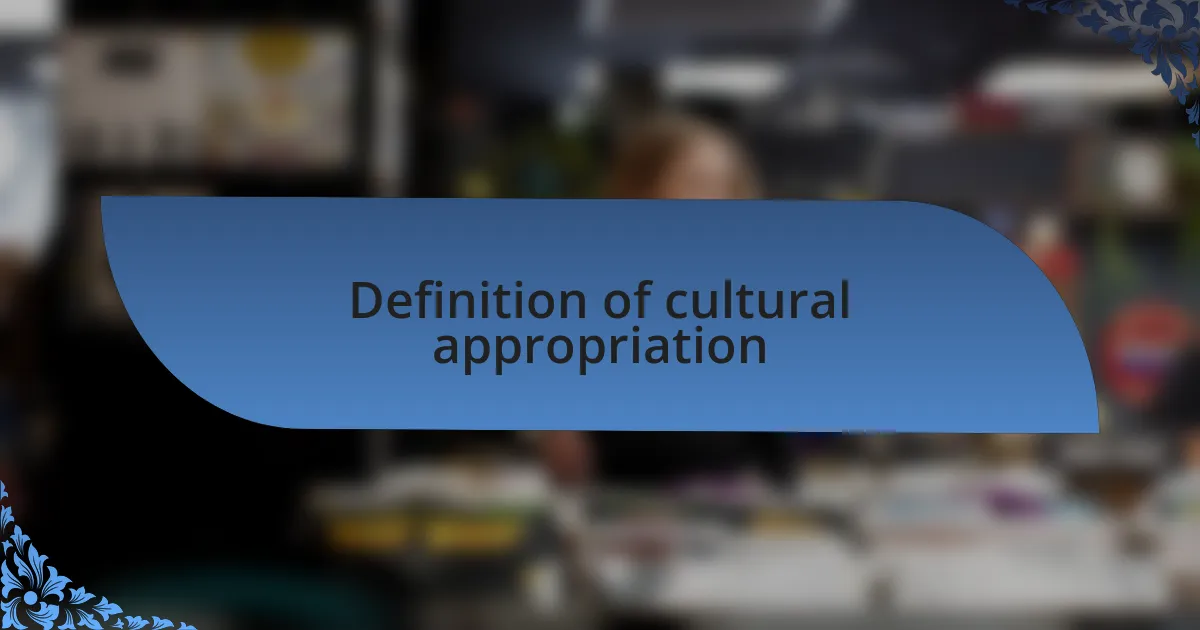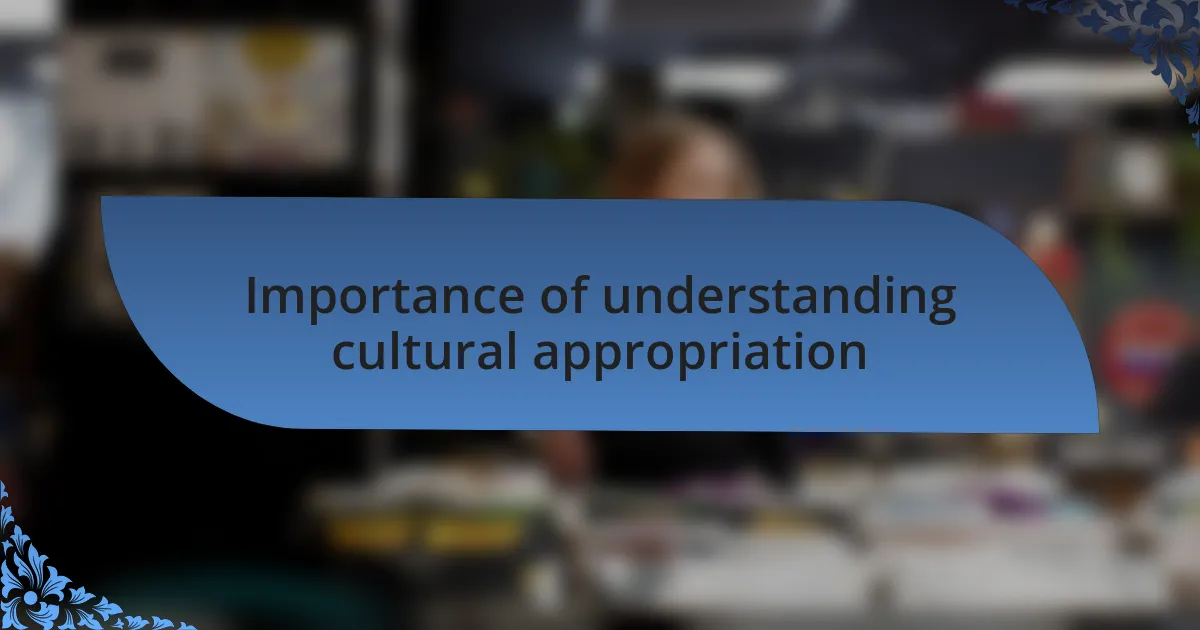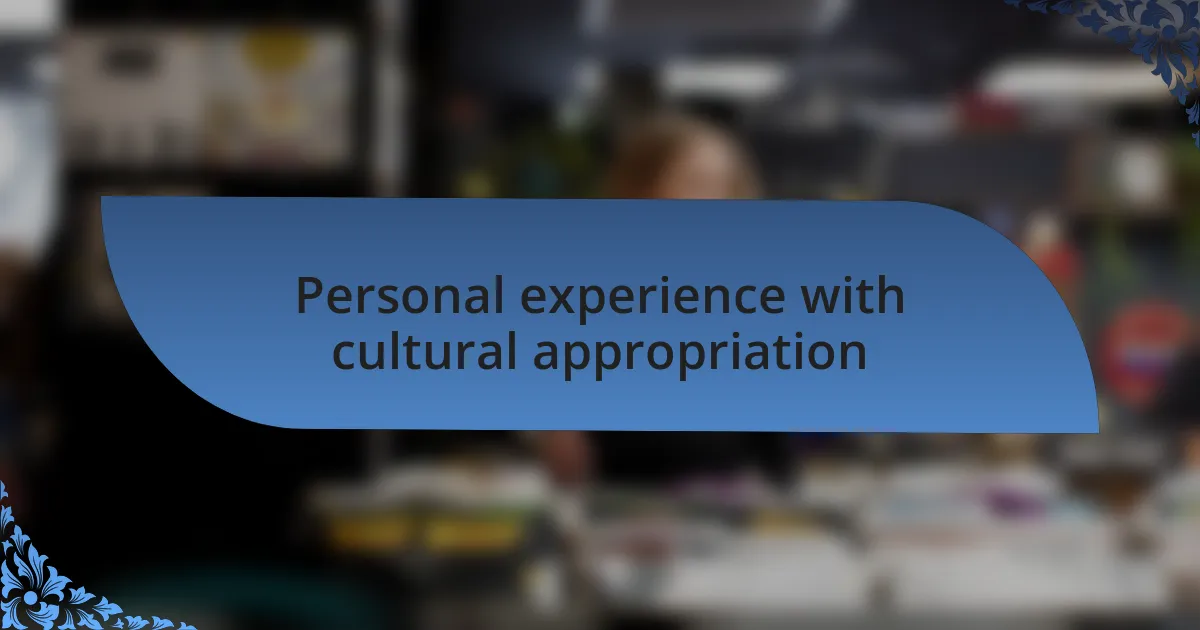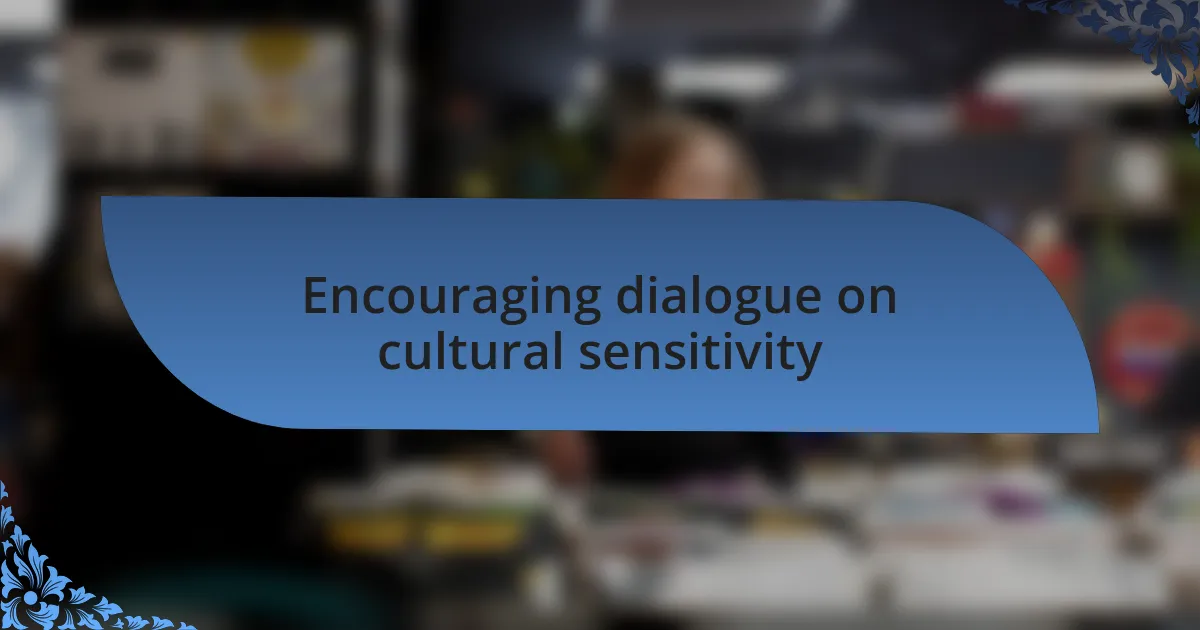Key takeaways:
- Cultural appropriation involves adopting elements from one culture by another without proper understanding, often raising ethical concerns surrounding power imbalances.
- Awareness and understanding of cultural appropriation promote empathy, respect, and critical engagement with different cultures.
- Respectful cultural sharing can be achieved through collaboration and direct engagement with individuals from those cultures, emphasizing the importance of context and significance.
- Fostering open dialogue about cultural sensitivity encourages mutual understanding and allows for the voices of marginalized cultures to be heard.

Definition of cultural appropriation
Cultural appropriation refers to the adoption of elements from one culture by members of another culture, often without permission or understanding. This phenomenon is frequently criticized when the appropriating culture is in a position of power over the appropriated one, leading to a complex web of ethical considerations. I find myself wondering, what happens when appreciation crosses the line into appropriation, and who gets to draw that line?
In my experience, I’ve noticed that cultural appropriation often manifests in art, fashion, and music, where elements are taken out of context. For example, I’ve seen friends wear traditional garments from cultures they have little connection to, sparking conversations about respect and understanding. It makes me realize the thin line between celebrating diversity and commodifying it, which can be a painful reality for those whose cultures are being appropriated.
This dynamic brings to light the often unacknowledged power imbalances at play, illustrating how voices from marginalized cultures can be overshadowed. Reflecting on these situations, I can’t help but think about the importance of dialogue and mutual respect in our increasingly interconnected world. How can we honor culture while avoiding appropriation? It’s a question that deserves our attention and thoughtfulness.

Importance of understanding cultural appropriation
Understanding cultural appropriation is crucial because it fosters a deeper awareness of the stories and histories behind cultural expressions. When I attended a cultural festival, I was struck by how many attendees wore traditional clothing without grasping their meaning. It made me wonder if we could bridge understanding through learning rather than borrowing superficially.
Awareness of this issue encourages empathy and respect for different cultures and their nuances. For instance, I once shared a meal with friends from a culture different from mine, where each dish held rich significance. This experience highlighted how much I hadn’t understood about their traditions and practices. It led me to realize that knowledge cultivates appreciation, while ignorance can inadvertently perpetuate stereotypes.
Recognizing cultural appropriation also prompts us to think critically about our roles in a multicultural society. I often reflect on how my own creative outputs can inadvertently borrow from other cultures. Am I truly appreciating, or am I extracting for my own benefit? Engaging with these questions helps to ensure that my creative expressions are informed, respectful, and inclusive, ultimately enriching the cultural tapestry we share.

Cultural appropriation in poetry
Cultural appropriation in poetry often manifests when poets adopt styles, themes, or symbols from cultures outside their own without proper context or understanding. I remember reading a powerful poem that beautifully blended imagery from ancient Indigenous culture alongside modern urban experiences. However, I couldn’t shake the feeling that the poet didn’t fully grasp or respect the deeper meanings woven into those symbols. It left me questioning: Can we truly honor a culture’s narrative if we haven’t taken the time to understand its origins?
The use of culturally specific language or form without engaging with its significance can dilute the authentic voices and histories that poetry aims to convey. I once attended a workshop where a poet recited verses inspired by a cultural tradition unfamiliar to them. While their enthusiasm was evident, it became clear to me that their approach lacked the necessary depth. This raised an essential inquiry for me: How can we elevate our art while being sensitive to the voices of communities whose stories deserve to be told by their own members?
When poets incorporate elements from other cultures, it’s vital that they do so with intention and insight. A close friend of mine, a poet herself, shared how she often collaborates with artists from various backgrounds, making it a priority to listen and learn before creating. This collaborative spirit fosters a richer poetic landscape and underscores a profound respect for the traditions being explored. Isn’t it fascinating how poetry can be both a personal expression and a communal dialogue, creating bridges rather than barriers?

Personal experience with cultural appropriation
I vividly recall a moment in university when a classmate used elements from my cultural heritage in their poem, intending to celebrate it. However, their portrayal felt like a superficial gloss over deep-rooted traditions. It was jarring to hear my culture reduced to mere imagery, making me wonder: How can we share cultural elements without reducing them to stereotypes?
During a recent poetry reading, I encountered a poet who shared their take on a well-known folktale from my background. Although the piece was skillfully crafted, I noticed they had missed the essence of the narrative. This experience evoked a mix of admiration and discomfort, prompting me to reflect: Is it possible to appreciate another culture’s story without truly understanding its significance?
I often engage in conversations with fellow poets about cultural representation. One poignant discussion involved a friend who expressed her reluctance to borrow from traditions outside her own, fearing misrepresentation. It left me pondering the balance between artistic freedom and respect for cultural authenticity. How do we navigate these waters without losing sight of the stories that shape us?

Ways to respectfully share cultures
One of the most effective ways to respectfully share cultures is through collaboration. I once participated in a poetry workshop where poets from diverse backgrounds came together to create a collective piece. This enabled us to explore each other’s stories and traditions, fostering a sense of shared ownership and respect. Have you ever been part of such a collaborative effort? It can lead to profound understanding and appreciation.
Engaging directly with individuals from different cultures is another powerful approach. I remember attending an event where cultural ambassadors shared stories, traditions, and their personal experiences. Listening to them speak about their heritage deepened my understanding and commitment to representing their culture accurately in my work. How often do we take the time to learn from the people behind the traditions we admire?
Lastly, educating ourselves about the histories and contexts of cultural elements we wish to use is essential. I make it a point to research thoroughly before integrating specific cultural references into my poetry. Understanding the rich tapestry of a culture allows us to appreciate it more fully, rather than merely appropriating it. Isn’t it vital to know what narratives we’re contributing to when we share another’s culture?

Encouraging dialogue on cultural sensitivity
Fostering open conversations about cultural sensitivity is crucial. I recall a time during a poetry reading when a fellow poet shared their struggle with cultural appropriation in their work. Their heartfelt story sparked a lively discussion among the audience, prompting many to reflect on their own practices. Have you ever had a moment where someone’s vulnerability changed your perspective?
Creating safe spaces for dialogue allows voices from all cultures to be heard. I once volunteered at a community center where we held workshops specifically around cultural storytelling. The warmth and respect in the room encouraged participants to share their truths without fear of judgment. Isn’t it amazing how understanding flows when we listen deeply and empathically to one another?
It’s also essential to approach these conversations with humility. I learned this when a mentor gently pointed out my unconscious biases in my poetry. That moment, though uncomfortable, opened my eyes to the importance of acknowledging my privilege and the responsibility that comes with it. How can we truly grow if we aren’t willing to examine our own beliefs and actions?